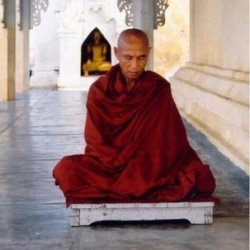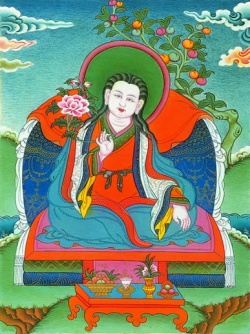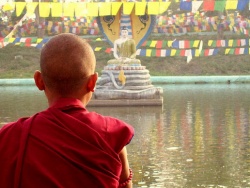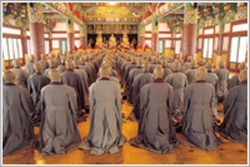Why do monks and nuns have their heads shaven?
Q1. Why do monks and nuns have their heads shaven?
In Buddha’s time, followers of monastic life already had their heads shaven. The Buddha prescribed their ascetic appearance with simple robes and a shaven head so that they would not become conceited and attach to their appearance and good looks. Shaving the head also signifies renunciation from worldly pleasures. From the traditional Buddhist viewpoint, hair represents impurity. Removing it symbolizes one’s dedication to eradicate all defilements.
Q2. What are the three circular marks on a monastic’s head?
During a Foguangshan monastic ordination, three pieces of burning incense are placed on a monastic’s head, thus producing permanent circular scars. These three marks represent:
1. The Triple Gem: the Buddha, the Dharma and the Sangha;
2. The three vows of ridding oneself of bad habits and thoughts, cultivating good, and having wisdom to help releasing others from suffering;
3. The Three Trainings: Morality/Discipline, concentration and wisdom
Q3. What is the structure of a regular Buddhist service?
A regular Buddhist service is usually a joint cultivation. Dharma instruments will be used to provide rhythm for chanting and singing. Usually there is the reading of a Sutra (Buddhist scripture) and chanting of Buddha’s name. Reading of different Sutras reminds us of the teaching of Buddha, and chanting of Buddha’s names helps to purify our mind and reminds us of their special virtues. Many a troubled mind has found solace upon chanting. Chanting and reading Sutras can generate merits which can promote good karma to grow, and prevent our misdeeds to germinate.
Q4. Why do Buddhists chant?
Chanting helps to stabilize and purify the mind by concentrationd gives the opportunity to learn and reflect upon various Buddhist teachings, as well as venerate Buddhas and Bodhisattvas and the virtues they embody. There are many different chants, the texts of which may be a Sutra (on Buddha’s teaching), mantras (short symbolic phrases) or names of Buddhas and Bodhisattvas. Chanting is often an integral part of Buddhist ceremonies and is important as a means of self cultivation.
Q5. Do people wear special clothes to attend Buddhist services?
In Buddhist services, normally lay Buddhists may wear a black robe which has the effect of solemnity and uniformity. It is of a traditional design common to Tang Dynasty when Buddhism was first established as a state religion in China. The black monotonous colour reduces distraction of mind, thus helping people to concentrate more. However, wearing the black robe may not be compulsory in temples.
Buddhists who uphold the Five Precepts or Bodhisattva Precepts may drape a brown precept robe over the black robe.
Q6. What is the meaning of burning incense in temples?
Burning incense in Buddhist altars is a kind of offering, an act of veneration for the Triple Gem (the Buddha, Dharma and Sangha) with a sincere heart. Aromatic incense purifies the atmosphere and reminds us to purify our mind. Just as its fragrance travels afar, so do good deeds extend to the benefit of all. Burning incense also embodies the transience and dissolution of phenomena.
Q7. What is the meaning of offering?
Most Buddhist altars display different kinds of offering. Making offerings allows one to practice giving, express gratitude and respect to the Triple Gem, and reflect upon the life sustaining law of interdependence. As such, making offering develops wholesome and positive karma, e.g.
l + Flower offering: Flowers are beautiful and fragrant, yet their splendor will not last forever, and as such they illustrate the impermanence of all things.
l + Fruit offering: It reminds us the result of our spiritual cultivation and the Law of Cause and Effect.
Q8. In rituals and in everyday life, Buddhists tend to burn incense. What is the purpose of burning this and how does this help?
Burning incense is a kind of offering, expressing gratitude and veneration to the Buddha. Also burning incense gives rise to a fragrance which is to purify the air and reminds us to purify our mind. Just as its fragrance travels afar, so do good deeds extend to the benefit of all.
Q9. Compared with traditional Buddhist rituals, what has changed today and how has this adapted to our everyday lives?
Straightly speaking, many rituals that you may see in Buddhist services or ceremony may not be passed down by the Buddha; instead they are much affected by the local traditions and culture. In general, a Buddhist service is a joint cultivation when devotees can get together and cultivate in a more effective environment. There are usually chanting Buddha’s name to concentrate and purify the mind, and reading of Sutras to remind us about the teaching of Buddha. Besides the regular Buddhist services, there may also be repentance services, memorial services for the deceased to show our gratitude and respect for them, or meditation retreat for mind cultivation. All these are for the cultivation of our virtues which are of timeless relevance, but of course with the advancement of scientific development nowadays, a wider range of modern facilities can be adopted.



